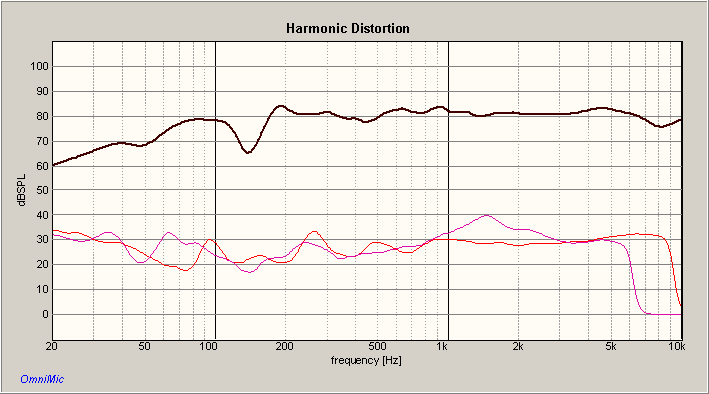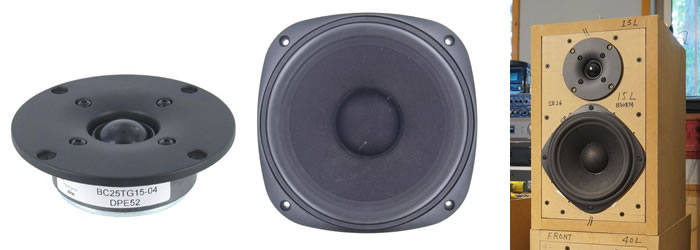|
SB Acoustics SB16PFC25-8 Paper Cone 6″ Woofer The SB16PFC25-8 woofer is one size up from the SB13PFC25 that I used in the Sparrow. It may not seem much, from a 5″ to a 6″ but the difference is shocking. What struck me first is the amount of bass this SB16PFC has. In full space, it is just about right. There’s definition and goes down low enough for most music. SB16PFC25-8 Frequency Response Fig 1 – SB Acoustics SB16PFC25-8 RAW Frequency Response. Nearfield measurement below 500Hz. One desirable feature of this 6″ woofer is the flatness of the response (Fig 1). It is virtually flat from 500Hz to 3kHz. Quite amazing because the response was taken with the SB16PFC in a 15 liters box with a baffle width of 8.5″. Due to it’s flatness, I don’t have to contend with a rising mid-range caused by baffle step. This is the first woofer that I encountered with this property. A designer’s dream. Peerless BC25TG15-04 Fig 2 – Peerless BC25TG15-04 RAW Frequency Response (Baffle Width = 8.5″) For the Lark, I decided to use a budget tweeter from Peerless. As can be seen in Fig 2, it is not flat like the one provided by the manufacturer. These “waves” are caused by Baffle Edge Diffraction when the tweeter is mounted onto a box whereas the response provided by Peerless is with the tweeter mounted onto a IEC baffle. Flush mounting will help to some degree at the higher frequencies but there’s no way to prevent the effects of diffraction below 2kHz. I should also point out that I removed the ferrofluid from this tweeter. When I initially tested it out, the tweeter sounded strange. Sometimes it was loud and at other times soft. When I opened it up to check the voice coil, I discovered the ferrofluid was not evenly distributed. In some places, only half the voice coil had ferrofluid. After I cleaned out all the ferrofluid, the tweeter behaves properly. The penalty for no ferrofluid is lesser power handling but since I have no intention of playing this speaker at insanely high volume, it is not an issue. Lark Frequency Response Fig 3 – Lark Frequency Response. Nearfield measurement below 500Hz The Black plot in Fig 3 is the summed response of the SB16PFC25 with the BC25TG15. Acoustically, the drivers are crossing at about 3kHz. At the crossover region, from 2kHz to 4kHz, the summed response is absolutely flat. Lark Harmonic Distortion Fig 4 – Lark 2nd and 3rd Harmonic Distortion. Disregard the notch at 150Hz. It’s caused by a floor bounce during measurement. Harmonic Distortion is generally -50dB below the fundamental (Fig 4). However, it recorded a broad peak at 1.5kHz. Measuring the woofer alone, it was determined that the distortion is in the SB16PFC25. Fortunately, it’s at -40dB below. On playback, I did not detect any issues. |
Sound of LarkThe Lark sounds beautiful. Though the bass is louder than the SB13PFC25, it does not over-power the mid-range. There’s punch when called upon and delivers great tempo too. A subwoofer is not needed with the Lark. The vocals are clear and distinct. Voices don’t shout at you. Neither are they recessed in the mix. Sibilance is well controlled. If it’s in the recording, it’ll be reproduced accurately. Not amplified or nulled off. As for the tweeter, I can find no fault. No harshness. The Peerless BC25TG15 may be cheap, but if used sensibly, it sounds fine, even with the ferrofluid removed. Considering that this is a budget speaker, the Lark’s performance is stellar. I highly recommend this build for those on a tight budget. |

October 15, 2017Projects